April 18, 2009
Is Albany Med flushing raw sewage and medical waste into the
Hudson River . . . via my neighborhood?
UPDATE – this is a difficult issue that I’ve been trying to wrap my head around for some time. Joe Cunniff has graciously provided some corrections to the article, hopefully everyone will come to understand this up until now invisible but vital issue better. The central point remains intact, some concern is dumping raw sewage into the Beaverkill, and that concern smells a lot like Albany Med.
We’re having a big problem with the capacity of our sewers here in the City of Albany. It’s not a new problem, and it’s not unique to our particular New York urban community. But it should come as no surprise that our current Albany City administration has so far utterly and completely ignored the problem as much as they can. That makes Albany unique.
The latest estimates are that it will cost ONE AND A HALF BILLION dollars to fix the combined sewer overflow problem in the City of Albany alone.
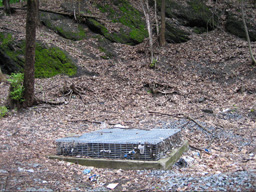 The Stinking Grate In The Ravine In Lincoln Park
The Stinking Grate In The Ravine In Lincoln Park
So far the fallout from the sewer overflow problem has been easy to overlook by the Jennings administration. It wasn’t until this year that Mayor Jerry Jennings admitted publicly that there might possibly be a problem with the drainage systems in Albany. This was at the Council of Albany Neighborhood Associations (CANA) meeting in February.
While talking around some other issue to the assembled crowd of neighborhood activists, The Mayor suddenly tossed into the middle of a sentence “…the sewer overflow problem may cost as much as a hundred million dollars to fix.” As He said this, I noticed a scared look come over His face, and his eyes darted from side to side as He looked for a reaction. Hearing none, the confident mask again slid over His visage and He quickly changed the subject.
I almost laughed out loud. Most of the CANA representatives listening to His Majesty knew perfectly well that the final cost of the overflow crisis may actually exceed TWO BILLION dollars in the City of Albany. But no one bothered to correct or challenge Him. We all gave up trying to educate The Mayor at public meetings a long time ago, let Him figure it out on His own.
What would be even funnier if it wasn’t such a potential disaster, is that the Capital District Regional Planning Commission (CDRPC) has been working on a plan to solve the sewer overflow crisis. Of all the local municipalities, only the City of Albany has refused to cooperate with creating both a plan and a pool of cash to deal with the problem. The Jennings administration consistently refuses to send a representative to the CDRPC meetings.
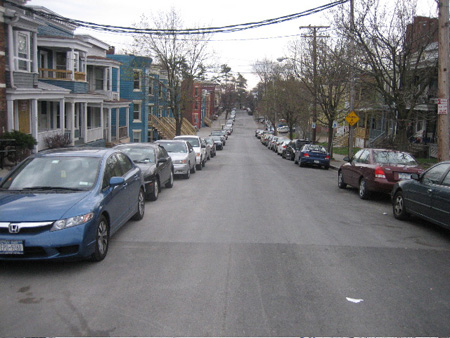 Elberon Street, Looking Down The Old Course Of The Beaverkill Toward Washington Park
Elberon Street, Looking Down The Old Course Of The Beaverkill Toward Washington Park
The combined sewer overflow crisis is already causing problems all over the City of Albany, and guaranteed to cause a lot more before the problem is fixed. Some of these problems are obvious, such as sewers backing up into basements in the Pine Hills neighborhood, or the spectacular geysers that shot out of manholes on South Pearl Street last summer. But some much more ominous problems are not so noticeable, such as the poisoning of the underground river in my neighborhood.
An underground river called the Beaverkill runs eastward through downtown Albany and empties into the Hudson River. Around 1840 the once pristine aboveground river had become an open sewer, so in the interest of public health the authorities confined the river to a big underground pipe. In the 20th Century the Beaverkill became part of the City’s storm drain system, collecting rain and snow melt from our streets.
The Beaverkill comes from the west down the middle of Elberon Street. Years ago I stuck my head into a manhole on Elberon, the pipe was easily five feet in diameter and the water rushed by in a loud and scary torrent. From Elberon the river enters Washington Park and emerges as Washington Park Lake.
The lake in Washington Park drains into another big pipe which crosses Madison Avenue and runs underneath the lower part of New Scotland Avenue. At the base of the hill, upon which sits the ever expanding Albany Medical Center complex, the Beaverkill makes an abrupt left turn and runs underneath Myrtle Avenue past the Stratton Veteran’s Administration hospital smokestack.
From there the Beaverkill snakes behind Hackett Middle School, and from there crosses Delaware Avenue into Lincoln Park. This is where, down in a ravine across from the elementary school in the park, the Beaverkill can be briefly observed through a grate, rushing loudly like a major waterfall. Sometimes in the spring, on a quiet morning, one can hear the river from up above on the road through the park. I always think of the sound as the ghost of the buried river.
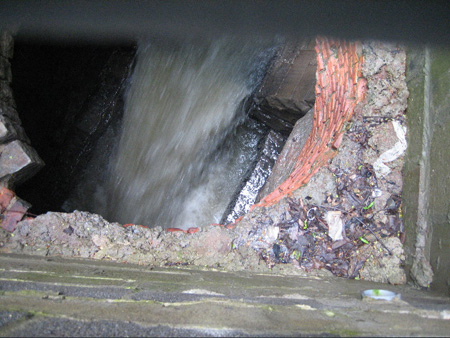 The Beaverkill Rushing Madly Inside The Grate
The Beaverkill Rushing Madly Inside The Grate
But holy hell on a horse does that grated opening stink. Like raw sewage, like sulfurous decay, like an army of dead things rising up from underground. It smells like the Rapp Road “landfill.” The horrible odor pours out of the grate, fills the ravine and crawls up onto the roadways to sicken passersby.
Now wait a minute here. Washington Park Lake emits a variety of odors, but I have never heard anyone complain that it smells like raw sewage. But after the river emerges from underground at the grate in Lincoln Park the rushing water is obviously carrying a lot of raw sewage.
We are forced to conclude that somewhere between points A and B, between Washington Park and Lincoln Park, the Beaverkill collects large quantities of raw sewage before it empties untreated into the Hudson River. And there is strong evidence that the Beaverkill is carrying a lot of disease causing pathogens.
Of course we can’t say exactly who is responsible for dumping large quantities of raw sewage into the Beaverkill, but we can deduce the most likely culprit. There is only one enterprise along that route that has been undergoing expansion this past decade, adding toilets and bodies to fill them. That would be Albany Medical Center.
You see, my neighbors first started noticing the stink from the grate in Lincoln Park about ten years or so ago. At first the sewage stink would rise out of the ravine only after a big rainfall then go away after a day or two. But as time went on the odor would linger longer and spread farther after the rains.
Today the stink is almost constant. During a dry spell the smell becomes less but it never quite goes away, not anymore. This increase of deathly odors in Lincoln Park coincides directly with the ongoing expansion of Albany Med. The more they build up there, the more we smell their shit down here in the South End.
 Where The Beaverkill Turns Left From New Scotland To Myrtle Avenue. The Albany Med Complex Can Be Seen Above And Behind This Intersection
Where The Beaverkill Turns Left From New Scotland To Myrtle Avenue. The Albany Med Complex Can Be Seen Above And Behind This Intersection
Albany Med has always been a bad neighbor, imposing its will upon surrounding neighborhoods, generating unnecessary noise, operating an illegal burn plant and pointedly refusing to cooperate with CDTA to provide and encourage public transit. Of course the hospital administrators don’t give a rat’s rear end about the sewage generated by their endless expansion projects. Who’s going to bother them about it, Jerry Jennings?
We could easily find out if Albany Med is responsible by dumping blue dye down their toilets and seeing if it comes out in the Hudson River. But I would be willing to make a small wager (I do not gamble) that the Albany Med administrators will desperately fight any attempt to determine if they are responsible for dumping raw sewage. After all, they are a profit making enterprise, taking responsibility for dumping medical waste does not enhance their “bottom line.”
Wait, it’s going to get worse. The next year or so the amount of sewage pouring through the Beaverkill is only going to increase in volume. You see, Albany Med is behind the “revitalization” of the part of the Park South neighborhood at the corner of New Scotland Avenue and Morris street. Basically, a lot of old two and three story houses are currently being torn down and replaced with massive multistory office buildings.
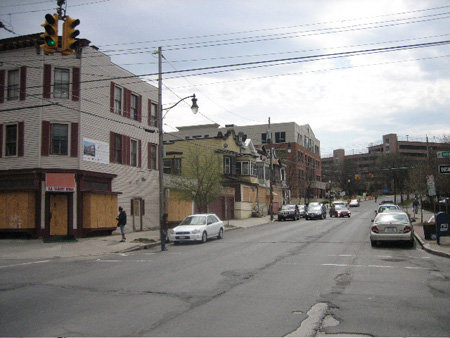 New Scotland Avenue Below Myrtle. Note The New Five Story Building And The Houses Slated For Demolition
New Scotland Avenue Below Myrtle. Note The New Five Story Building And The Houses Slated For Demolition
Of course these big new office buildings will connect every single one of their new toilets to the nearest working sewer line. Perhaps they will all connect directly into the Beaverkill. If not, then most certainly they will connect to the undersized sewer line that is spilling contents into the Beaverkill.
I have yet to hear anyone suggest that the Albany Med expansion should include increased sewer capacity. Indeed, it has become clear that the Beaverkill does not exist as far as the regional planners at CDRPC are concerned. This major drainage route does not even appear on their most detailed maps. This can only be deliberate, otherwise how can the CDRPC planners ignore the Beaverkill?
This brings us to the other problem besides odor. How much of that raw Albany Med sewage is medical waste? Exactly what communicable diseases are spilling through Lincoln Park and entering the Hudson River?
One of the major things that distinguishes the good old USA from third or second world countries is our excellent sewage treatment and disposal system. Because of our excellent system coupled with strong environmental laws, dysentery type diseases such as cholera and typhus are almost unknown in this country.
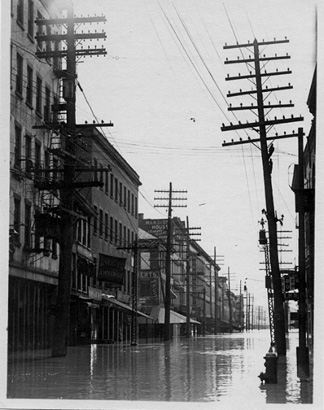 South Pearl Street In Albany, 1913
South Pearl Street In Albany, 1913
The last waterborne outbreak of disease in Albany was the Typhus Epidemic of 1913, less than a hundred years ago. Caused by filthy Hudson River water backing up into the City’s water distribution system during a massive springtime flood, the epidemic raged up out of the South End and struck at the City and State legislators and their families perched uphill above the flood waters.
The politicians resolved to protect themselves from a repeat of the typhus epidemic, an extremely unpleasant disease. The state leaders created Great Lake Sacandaga to control the water level of the Hudson, and the City politicians began to build the inland reservoir system that provides fresh drinking water, far from the Hudson. Both of these water systems, much abused and taken for granted, are in good working order today.
But now we appear to be going back to square one. Check out these two charts which I pulled with great difficulty from the nearly unavigable CDRPC site:
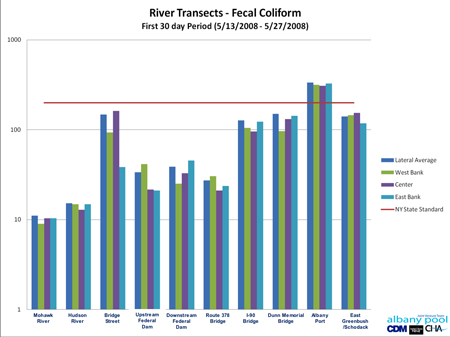
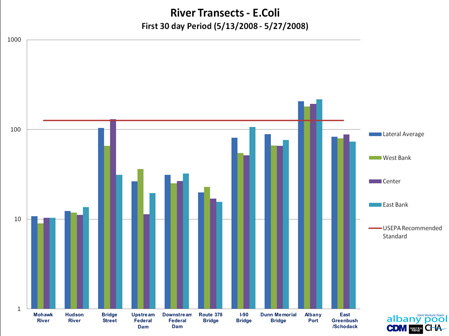 Click on the image to see both charts at full size
Click on the image to see both charts at full size
The two charts show e. coli and fecal coliform in the Hudson River at various test sites along our part of the Hudson. That red line is the amount of crap and disease that New York State allows in the water. You can bet that the state standard is not very strict, they allow more filth than we really want in our river.
Notice that the worst crap and disease laden spot is the Port of Albany… which is just a little ways downstream from the enormous pipe that comes out of the parking lot of the U-Haul building. This is the terminus of the Beaverkill.
In the photo below, you can see that I’ve cajoled The Wife into paddling her canoe up to the mouth of the Beaverkill. She is complaining bitterly about the odor, and is telling me to hurry up and snap the picture so she can get away from the stink. How that woman suffers for me.
 Where The Beaverkill Meets The Hudson
Where The Beaverkill Meets The Hudson
So in conclusion, there is strong evidence that Albany Medical Center is pouring infectious diseases into the waters of the Hudson along the South End. But first, they are stinking up my neighborhood and possibly exposing my neighbors to infectious disease. Why should they care about those of us who live in the South End? Why should Jerry Jennings?
Like most municipalities in New York, there are two drainage systems in the City of Albany. One is the sewers, that friendly underground series of tubes that quietly carry away your business after you flush your toilet. This dirty water goes to one of several sewage treatment plants where the water is cleaned quite well and then sent into the Hudson.
The other drainage system is the storm drains, the grates on the streets that collect runoff from rain and snow. This water, though not exactly clean, does not carry the kind of bacteria that likes to breed in raw sewage, such as cholera and typhus. Because there is no infectious medical hazard the water is generally dumped directly into the river.
The two systems are separate, as they should be, except at the overflow points. These overflow points are built into the system so that if, say, there is a massive rainstorm that is too much for the storm drains, the clean rainwater running underground will slop over a concrete wall into the dirty sewer water system. One could say that the overflow points act as safety valves for the storm drains during torrential storms.
Fine, as long as the clean water occasionally mixes with the dirty water, no big deal. That’s what it’s supposed to do. But what’s happening is that dirty sewer water is regularly and consistently slopping over into the storm drain clean water conduits. The storm drains, in effect, have become open sewers. And some of these open sewers stink like hell.
Obviously, this problem did not happen overnight, it took a lot of neglect and irresponsible behavior by a succession of City administrations. Basically, as the City of Albany has sprawled westward over the past sixty years or so, there has been no requirement for planners or developers to modify the two drainage systems. There was no effort to build new drainage for the new houses, roads and later on, endless parking lots extending out into the suburbs.
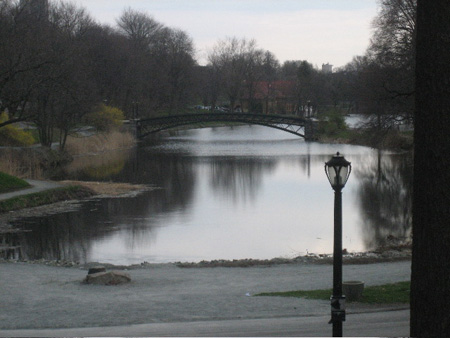 Washington Park Lake: Clean Water
Washington Park Lake: Clean Water
Instead, starting in the 1940s, the new sewers and storm drains were plugged directly into the existing drainage system in downtown Albany. This was when most of the Pine Hills neighborhood was built on pristine Pine Bush land, thus the name. And because Pine Hills was the first of the new developments after World War 2, this is where the household sewer lines back up and fill basements.
You see, Pine Hills has the first of the wider gauge higher capacity sewer and storm drain pipes. Everything built to the west of Pine Hills also has wider gauge pipes. Which is great, all those uptown toilets and parking lots need those extra capacity pipes.
Except for one problem. The ancient downtown drainage pipes, which worked just fine before the City sprawled westward, are of a smaller gauge. When there’s a big storm, all that water from uptown (and beyond) runs downhill smack dab into those smaller gauge pipes that start on the eastern edge of Pine Hills. The water has gotta go somewhere, that’s when the homeowners of Pine Hills get basements full of poop.
It was in the late 1990s that the sewer lines in Pine Hills first started to back up. And it was about that time that my neighbors first noticed the stink of Albany Medical Center wafting through Lincoln Park. The problem, like a graveyard full of rotting zombies from a bad movie, began at that time to rear up from under the dirt in various locations around the City.
You know, that spot in Lincoln Park where the Beaverkill emerges is beautiful spot. A hundred years ago, before the Beaverkill was transformed into a storm drain, “The Ravine” was a tourist destination that was the subject of postcards, such as this one from 1907:
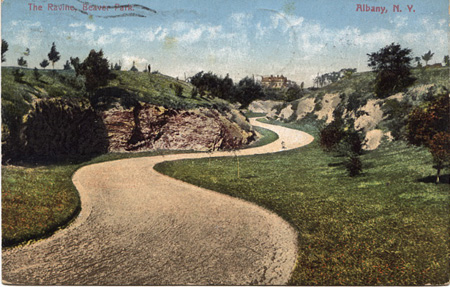 The Ravine In Beaver Park, Now Called Lincoln Park
The Ravine In Beaver Park, Now Called Lincoln Park
And today it’s a lovely spot:
 The Ravine, Photo Taken Last Spring
The Ravine, Photo Taken Last Spring
A wonderful place to have a picnic, except for one problem. Anybody with even a marginal sense of smell who tries to have a meal down here is more likely to throw up than eat. And nobody can stand to spend more than a few minutes admiring the natural rock walls.
I’d sure like to be able to have a picnic down there, to see the ravine once again become a place of pride. But I’m afraid that the odor and the risk of disease is only going to become worse in the next few years. I’m not holding my breath waiting for something to be done… or rather, I am.
Thanks to Joe Cunniff of the Pine Hills Neighborhood Association for providing some of the information for this article. And thanks to both Joe and First Ward common council member Dominick Calsolaro for regularly attending the CDRPC meetings on their own time.
Prior Post * * * Next Post